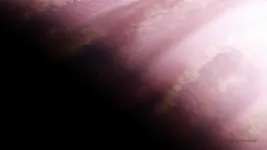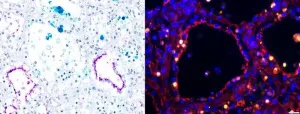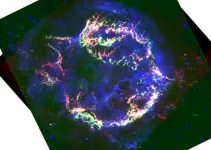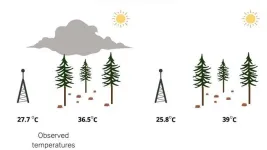(Press-News.org) HOUSTON - (July 15, 2024) - As parents, teachers and pet owners can attest, rewards play a huge role in shaping behaviors in humans and animals. Rewards – whether as edible treats, gifts, words of appreciation or praise, fame or monetary benefits – act as positive reinforcement for the associated behavior. While this correlation between reward and future choice has been used as a well-established paradigm in neuroscience research for well over a century, not much is known about the neural process underlying it, namely how the brain encodes, remembers and translates reward cues to desired behaviors in the future.
A recent study led by Dr. Sameer Sheth, professor and vice chair of research in the Department of Neurosurgery at Baylor College of Medicine, director of the Gordon and Mary Cain Pediatric Neurology Research Foundation Laboratories and investigator at the Jan and Dan Duncan Neurological Research Institute (Duncan NRI) at Texas Children’s Hospital, identified beta frequency neural activity in the anterior cingulate cortex (ACC) of the brain’s frontal lobe as the key neural signature underlying processes associated with recognizing rewards and determining subsequent choices and, thus, shaping future behaviors.
Furthermore, the study, published in Nature Communications, reports this neural signature is altered in patients with depression, opening an exciting possibility of using these neural signals as a new biomarker and a potential innovative avenue for therapy.
Anhedonia is a cardinal symptom of depression and other psychiatric conditions
Human beings derive pleasure through various physical or mental activities, sensory experiences and interactions with family and friends. However, individuals with depression often experience feelings of hopelessness, sadness or despair for prolonged periods due to disengagement and anhedonia – a medical term meaning loss of the ability to feel joy or contentment in activities and things that they once found pleasurable, all of which has a profound negative impact on their quality of life.
Anhedonia is also associated with other psychiatric and neurological disorders such as schizophrenia and bipolar disorder, substance abuse disorder, anxiety and Parkinson’s disease. Traditional antidepressants and standard treatments often fail to adequately address this symptom in individuals with severe treatment-resistant depression and other conditions. A better understanding of anhedonia can guide the development of targeted and more effective treatments for depression and related conditions.
Reward bias response is regulated by beta activity in the frontal lobe
To identify the underlying neural basis for anhedonia, Sheth and team recorded and analyzed neural activity from four brain regions of 15 patients with medication-resistant epilepsy who were undergoing invasive monitoring to localize the zone from where their seizures originated.
As their brain activity was being monitored, these patients performed a perceptual discrimination task called the probabilistic reward task (PRT), a well-validated behavioral task that objectively measures anhedonia by observing subtle changes in behavior related to reward.
“We found that the unequal assignment of reward between two correct responses in this task produced a response bias toward the more frequently rewarded stimulus,” said lead author Dr. Jiayang Xiao, who conducted this study as a graduate student in the Sheth lab. “We found that based on feedback, most individuals modified their subsequent responses to make choices that were likely to get rewarded, irrespective of the accuracy of their answers.”
Moreover, they found a specific signal – neural oscillations in the beta frequency range – originating from the anterior cingulate cortex (ACC) in the frontal lobe of the brain, showed a consistently strong and positive correlation with the reward bias behavior and tracked closely with the receipt of rewards and their value. Further, they found that this specific brain region was engaged in evaluating both reward stimuli and outcomes, potentially acting as a critical node with a common mechanism for reward assessment.
“Our study has addressed a longstanding fundamental question in neuroscience – which specific brain region and signal regulates the classic reward bias response, a famous example of which is the Pavlovian conditioning where dogs learned to associate the sound of a ringing bell to food,” said co-senior author Dr. Benjamin Hayden, professor of neurosurgery at Baylor.
Reward bias response is altered in patients with treatment-resistant depression
Next, Sheth and his team conducted the PRT in four individuals with severe treatment-resistant depression. They found that reward processing in the ACC was altered in this group. These individuals did not exhibit the typical behavioral response of favoring choices that are more frequently rewarded. This observation suggests a lack of reward-oriented anticipation and that their choices were less driven by reward feedback. Consistent with this change in reward bias behavior, beta activity in the ACC region was reduced and delayed in these individuals.
“In this study, we identified beta activity in the ACC as a potential biomarker for anhedonia,” said Sheth, also a McNair Scholar and Cullen Foundation Endowed Chair at Baylor. “Such a biomarker could have many potential benefits, including improving diagnosis and monitoring symptoms of patients with severe depression and other anhedonia-related psychiatric conditions. Moreover, our findings present an exciting possibility that modulation of the ACC beta activity might be effective treatment anhedonia, a hypothesis we plan to test in future clinical trials.”
The neurotechnology advancements of this research have advanced at a pace not previously possible due in part to funding by the National Institutes of Health Brain Research Through Advancing Innovative Neurotechnologies Initiative, or the BRAIN Initiative.
“This study exemplifies how BRAIN-funded research is already having an impact in the clinic today,” said Dr. John Ngai, director of the NIH BRAIN Initiative. “The innovations in data collection and individualized deep brain stimulation demonstrated in this study may enable a new generation of precision treatments.”
Information about other authors involved in the study, their affiliations and their declaration of interest can be found here. This research reported in this press release was supported by the National Institutes of Health by award numbers UH3 NS103549, K01 MH116364, R21 NS104953, UH3 NS100549, and R01 MH114854; and the McNair Medical Institute at the Robert and Janice McNair Foundation. The researchers would also like to thank the Cullen Foundation, the Jan and Dan Duncan Neurological Research Institute, and the Gordon and Mary Cain Pediatric Neurology Research Foundation Labs at Texas Children’s Hospital.
END
A novel and unique neural signature for depression revealed
2024-07-15
ELSE PRESS RELEASES FROM THIS DATE:
Academic psychiatry urged to collaborate with behavioral telehealth companies
2024-07-15
Waltham — July 15, 2024 — The strengths of academic psychiatry departments and the fast-growing private telehealth sector are complementary, according to a Perspective article published in Harvard Review of Psychiatry, part of the Lippincott portfolio from Wolters Kluwer. Justin A. Chen, MD, MPH, a psychiatrist at Weill Cornell Medicine in New York City, and colleagues reviewed literature on provision of outpatient mental health care in the United States. They concluded that academic psychiatry departments and telehealth companies could mutually benefit from strategic collaboration.
Academic medical centers struggle to ...
NASA’s Webb investigates eternal sunrises, sunsets on distant world
2024-07-15
Researchers using NASA’s James Webb Space Telescope have finally confirmed what models have previously predicted: An exoplanet has differences between its eternal morning and eternal evening atmosphere. WASP-39 b, a giant planet with a diameter 1.3 times greater than Jupiter, but similar mass to Saturn that orbits a star about 700 light-years away from Earth, is tidally locked to its parent star. This means it has a constant dayside and a constant nightside—one side of the planet is always exposed to its star, while the other is always shrouded in darkness.
Using Webb’s NIRSpec (Near-Infrared ...
Receptors make dairy cows a prime target for influenza, ISU team finds
2024-07-15
AMES, Iowa – As highly pathogenic avian influenza has spread in dairy herds across the U.S., the virus is being detected in raw milk. A new study by a broad team of researchers at Iowa State University’s College of Veterinary Medicine helps explain why.
Sialic acid, a sugar molecule found on the surface of some animal cells, acts as a receptor for influenza. Without sialic acid providing an entry point to attach, invade and infect, a flu virus is unlikely to find a potential host hospitable.
Before the recent HPAI outbreak ...
A new neural network makes decisions like a human would
2024-07-15
Humans make nearly 35,000 decisions every day, from whether it’s safe to cross the road to what to have for lunch. Every decision involves weighing the options, remembering similar past scenarios, and feeling reasonably confident about the right choice. What may seem like a snap decision actually comes from gathering evidence from the surrounding environment. And often the same person makes different decisions in the same scenarios at different times.
Neural networks do the opposite, making the same decisions each time. Now, Georgia Tech researchers in Associate Professor Dobromir Rahnev’s lab are ...
Wojtusiak to use artificial intelligence to help caregivers with social isolation
2024-07-15
Janusz Wojtusiak, Professor, Health Administration and Policy, College of Public Health, is set to receive funding for the project: “An Artificial Intelligence Solution to Social Isolation and Longlines of Caregivers of People with Dementia.”
Wojtusiak and his graduate student Ghaida Alsadah will lay the foundation for a large study aimed at utilizing AI methods to address social isolation and loneliness among people who care for those with Alzheimer’s Disease and those suffering from dementia.
Addressing ...
You're just a stick figure to this camera
2024-07-15
Images
A new camera could prevent companies from collecting embarrassing and identifiable photos and videos from devices like smart home cameras and robotic vacuums. It's called PrivacyLens and was made by University of Michigan engineers.
PrivacyLens uses both a standard video camera and a heat-sensing camera to spot people in images from their body temperature. The person's likeness is then completely replaced by a generic stick figure, whose movements mirror those of the person it stands in for. The accurately animated stick figure allows a device relying on the ...
Scorching storms on distant worlds revealed in new detail
2024-07-15
Astronomers have created the most detailed weather report so far for two distant worlds beyond our own solar system.
The international study – the first of its kind – reveals the extreme atmospheric conditions on the celestial objects, which are swathed in swirling clouds of hot sand amid temperatures of 950C.
Using NASA’s powerful James Webb Space Telescope (JWST), researchers set out to capture the weather on a pair of brown dwarfs – cosmic bodies that are bigger than planets but smaller than stars.
These brown dwarfs, named collectively ...
JWST unveils stunning ejecta and CO structures in Cassiopeia A's young supernova
2024-07-15
July 15, 2024, Mountain View, CA -- The SETI Institute announced the latest findings from the James Webb Space Telescope (JWST) of the supernova remnant, Cassiopeia A (Cas A). These observations of the youngest known core collapse supernova in the Milky Way provide insights into the conditions that lead to the formation and destruction of molecules and dust within supernova ejecta. The study’s findings change our understanding of dust formation in the early universe in the galaxies detected by JWST 300 million years after the Big Bang. ...
UC Irvine Earth system scientists discover missing piece in climate models
2024-07-15
Irvine, Calif., July 15, 2024 — As the planet continues to warm due to human-driven climate change, accurate computer climate models will be key in helping illuminate exactly how the climate will continue to be altered in the years ahead.
In a study published in the Journal of Geophysical Research: Atmospheres, a team led by researchers from the UC Irvine Department of Earth System Science and the University of Michigan Department of Climate and Space Sciences and Engineering reveal how a climate model commonly used by geoscientists currently overestimates ...
Wildfire smoke has a silver lining: It can help protect vulnerable tree seedlings
2024-07-15
CORVALLIS, Ore. – Forest scientists at Oregon State University studying tree regeneration have found that wildfire smoke comes with an unexpected benefit: It has a cooling capacity that can make life easier for vulnerable seedlings.
An OSU College of Forestry collaboration led by faculty research assistant Amanda Brackett made the discovery while working to determine the effect of forest canopy cover on summer maximum temperatures near ground level.
The study’s goal was to describe how heat waves and other future climate conditions might affect canopy cover’s influence on temperature. The scientists used previously established heat stress responses of seedlings from ...



